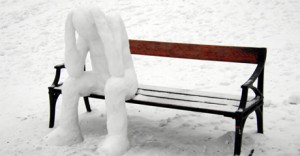Seasonal Affective Disorder (winter depression & summer depression)
Seasonal Affective Disorder (SAD) is a type of depression that returns about the same time every year. Approximately 4 to 6% of the population is affected by seasonal affective disorder. Other names for seasonal affective disorder are winter depression, winter blues, summer depression, summer blues, or seasonal depression. People usually do not realize they have SAD, because it goes away after a few months, and because it is quite normal to stay home more often during the cold months. A missed chance, because seasonal affective disorder can be treated effectively.
Seasonal affective disorder is considered to be a mood disorder that occurs at a specific time in the year and fully remits otherwise. To be diagnosed with a seasonal affective disorder one must experience depressive episodes at a particular time of the year and experience no depressive episodes throughout the rest of the year. This pattern must have lasted two years without experiencing a non-seasonal major depressive episode.
At Barends Psychology Practice, we treat depression Online and in person. Book your first free session now. Go to Contact us. (Depending on your health insurance, treatment may be reimbursed).
Seasonal affective disorder – symptoms
In general the seasonal affective disorder symptoms have a lot in common with a major depressive disorder. Symptoms major depressive disorder and SAD have in common are:
- Feeling depressed, most of the day, nearly every day.
- Loss of interest in things you used to enjoy.
- Loss of energy.
- Feeling hopelessness.
- Changes in appetite and sleep and/or weight.
- Difficulty concentrating.
- Thoughts of suicide.
However, some symptoms are specific of seasonal affective disorder and are slightly different for the times of the year (winter and summer) and also for men and women. The reason behind these differences may be explained by the fact that during the winter there is less sunlight (days are shorter) compared to the summer. And during the summer the days are longer, the temperatures rise and everyone around you is happy. The differences for men and women may be explained by the different ways men and women respond to changes in their hormone levels. A brief overview of the differences:
Seasonal affective disorder – Symptoms – Winter vs. Summer
Winter:
- Feeling tired, or having little energy.
- Having the feeling that your arms and legs are 10x as heavy as they actually are.
- Problems in social interaction.
- Desire to be alone.
- Irritability and/or hypersensitive to rejection.
- Changes in appetite (often weight gain).
- Oversleeping.
Summer:
- Feeling depressed.
- Weight loss.
- Poor appetite.
- Anxiety or agitation.
- Trouble sleeping.
Seasonal affective disorder – Symptoms – Women vs. Men
Women more often than men:
- Blame themselves.
- Feel sad, apathetic, and worthless.
- Feel anxious and scared.
- Find it easy to talk about despair and self-doubt.
- Have trouble setting boundaries.
- Feel slowed down and nervous.
- Avoid conflicts.
- Use food, friends and “love” to self-medicate.
Men more often than women:
- Blame others.
- Feel irritable, angry, and ego inflated.
- Feel guarded and suspicious.
- Don’t talk about despair or self-doubt.
- Need to feel in control.
- Feel agitated and restless.
- Create conflicts.
- Use sports, alcohol, and sex to self-medicate.
(Advertisement. For more information, please scroll down.)
Seasonal affective disorder – Causes
What causes seasonal affective disorder remains unclear, but there are some factors that may trigger of (partially) cause SAD:
- Circadian rhythm (biological clock): the short days during the winter make it difficult for your body to catch enough sunlight. Sunlight is needed to time certain biological processes like mood, sleep, appetite, energy levels and digestion [1]. If this circadian rhythm is disturbed it may lead to seasonal affective disorder symptoms. In more detail: the shortage of sunlight affects certain hormones and chemicals in your brain, like melatonin and serotonin. Melatonin affects our sleep. When it is dark a gland called the pineal gland produces melatonin to make you feel sleepy. When it is light you produce less melatonin. But some people produce more than average melatonin during the winter months, resulting in SAD symptoms as sleepiness and lack of energy. Serotonin affects mood, appetite and sleep. Less serotonin is produced when there is less sunlight. During the winter you may have lower than average levels of serotonin, which may lead to symptoms of seasonal affective disorder, such as feeling down.
Seasonal affective disorder – Treatment
If you recognize some or all of the SAD symptoms in yourself, then treatment is recommended. At Barends Psychology Practice, online counseling is offered for people who have seasonal affective disorder.
Light therapy and fluoxetine are equally effective when it comes to treating SAD. Light therapy, however, show more improvement during the first week after the start of the therapy, compared to fluoxetine. This effect is gone after one week [2].
Light therapy in combination with Cognitive Behavioural Therapy (CBT), Light therapy alone or CBT alone are effective ways to treat SAD. CBT alone or in combination with Light therapy showed more long-term effects: a year later SAD patients who had been treated with CBT alone or in combination with Light therapy were less likely to relapse and experienced the SAD not at all or less severe compared to those who used Light therapy alone [3].
(Advertisement. For more information, please scroll down.)
Literature used for this article:

